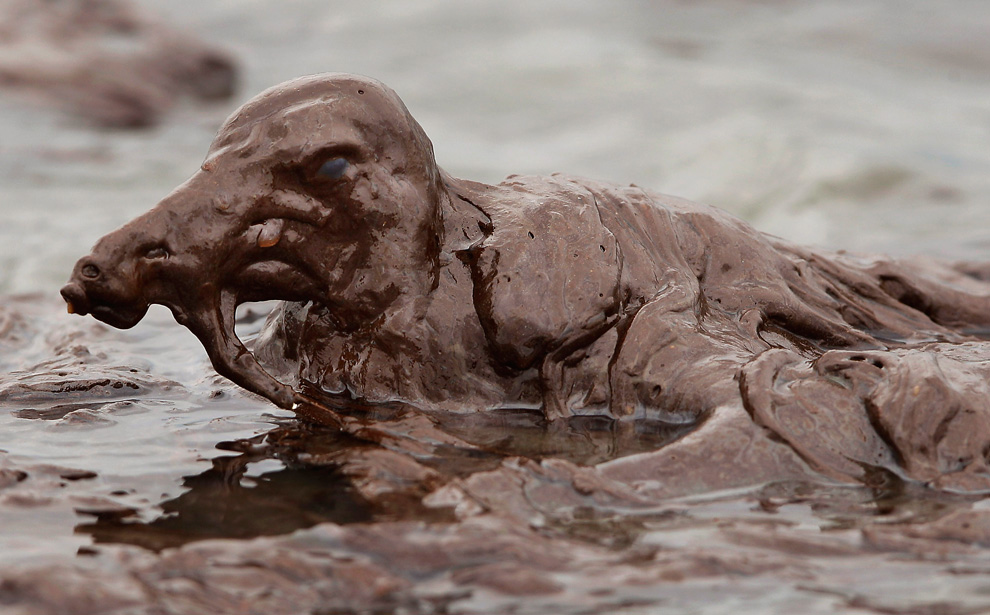
The quotes above are taken from Real Climate.May 19: BP announces it's "very pleased" with the performance of the insertion tube, as oil blankets Louisiana's wetlands, fishermen are sickened, and the slick is caught by the loop current.
May 26: "As the admiral has mentioned, it's disappointing, we do have oil ashore at nine different locations in the state of Louisiana," Suttles says, before finding a silver lining. "But we still have no oil ashore in either Alabama, Mississippi, or Florida, which we're very pleased about".
May 27: "As I've mentioned before, the equipment actually has performed very well," Suttles says about the top kill effort, which replaced the failed riser insertion tube. "We are very pleased with the performance of the equipment so far".
May 28: "I've done this many, many times now and I can tell you that the battle offshore, we're winning that battle," Suttles claims. "It's the least amount of oil that I've seen offshore since my very first flight, so I'm very, very pleased with the activity of the offshore team."
May 29: "I'm very pleased to say the amount of oil on the surface of the sea continues to be reduced," Suttles bizarrely claims, as BP abandons the failed "top kill" effort.
June 5: "Over the last 24 hours we've been able to collect 6,000 barrels of oil," BP Senior Vice President Bob Fryar tells reporters in Mobile, AL, "so we're very pleased with that operation".
BP's public relations campaign is well underway. "This wasn't our accident," chief executive Tony Hayward told ABC's George Stephanopoulos earlier this month. Though he accepted responsibility for cleaning up the spill, Hayward emphasized that "this was a drilling rig operated by another company."Communities destroyed by oil spills have heard this kind of thing before. In 1989, Exxon executive Don Cornett told residents of Cordova, Alaska: "You have had some good luck, and you don't realize it. You have Exxon, and we do business straight. We will consider whatever it takes to keep you whole." Cornett's straight-shooting company proceeded to fight paying damages for nearly 20 years. In 2008, it succeeded -- the Supreme Court cut punitive damages from $2.5 billion to $500 million.
As the spill progressed, Exxon treated the cleanup like a public relations event. At the crisis center in Valdez, company officials urged the deployment of "bright and yellow" cleanup equipment to avoid a "public relations nightmare." "I don't care so much whether [the equipment is] working or not," an Exxon executive exhorted other company executives on an audiotape our plaintiffs cited before the Supreme Court. "I don't care if it picks up two gallons a week."
Even as the spill's long-term impact on beaches, herring, whales, sea otters and other wildlife became apparent, Exxon used its scientists to run a counteroffensive, claiming that the spill had no negative long-term effects on anything. This type of propaganda offensive can go on for years, and the danger is that the public and the courts will eventually buy it. State and local governments and fishermen's groups on the Gulf Coast will need reputable scientists to study the spill's effects, and must work tirelessly to get the truth out.
Remember: When the spiller declares victory over the oil, it's time to raise hell.
Hi John,It just occurred to me that if you haven't read Tim Flannery's book, The Future Eaters, I think you would find it fascinating. If you haven't read it, a quick synopsis: the many lands of Australasia have been the site of an amazing variety of experiments on what human and ecological history looks like under severe resource constraints (e.g. when the Maori wiped out all the moa). Flannery goes way beyond the surface stories of mass extinctions (e.g. Jared Diamond's book, Collapse) into the detailed data and dynamics of many, many examples both positive and negative. The lessons are often surprising.
Cheers,
– Chris
BP Buys 'Oil' Search Terms to Redirect Users to Official Company WebsiteBill Schmitt and I went to Joshua Tree National Park today, and he took these pictures. Click on them to see bigger versions:ABC News, Emily Friedman
June 5, 2010Be careful where you click, especially if you're looking for news on the BP oil spill.
BP, the very company responsible for the oil spill that is already the worst in U.S. history, has purchased several phrases on search engines such as Google an d Yahoo so that the first result that shows up directs information seekers to th e company's official website.
A simple Google search of "oil spill" turns up several thousand news results, bu t the first link, highlighted at the very top of the page, is from BP. "Learn mo re about how BP is helping," the link's tagline reads.
For an earlier round of Joshua Tree photos, taken back in
2004, go here.
June 6, 2010
The CIA has opened a new Center
on Climate Change and National Security:
Its charter is not the science of climate change, but the national security impact of phenomena such as desertification, rising sea levels, population shifts, and heightened competition for natural resources. The Center will provide support to American policymakers as they negotiate, implement, and verify international agreements on environmental issues. That is something the CIA has done for years. "Decision makers need information and analysis on the effects climate change can have on security. The CIA is well positioned to deliver that intelligence," said Director Leon Panetta.
Stewart Brand's summary:
Engineer Griffith said he was going to make the connection between personal actions and global climate change. To do that he's been analyzing his own life in extreme detail to figure out exactly how much energy he uses and what changes might reduce the load. In 2007, when he started, he was consuming about 18,000 watts, like most Americans.The energy budget of the average person in the world is about 2,200 watts. Some 90 percent of the carbon dioxide overload in the atmosphere was put there by the US, USSR (of old), China, Germany, Japan, and Britain. The rich countries have the most work to do.
What would it take to level off the carbon dioxide in the atmosphere at 450 parts per million (ppm)? That level supposedly would keep global warming just barely manageable at an increase of 2 degrees Celsius. There still would be massive loss of species, 100 million climate refugees, and other major stresses. The carbon dioxide level right now is 385 ppm, rising fast. Before industrialization it was 296 ppm. America's leading climatologist, James Hansen, says we must lower the carbon dioxide level to 350 ppm if we want to keep the world we evolved in.
The world currently runs on about 16 terawatts (trillion watts) of energy, most of it burning fossil fuels. To level off at 450 ppm of carbon dioxide, we will have to reduce the fossil fuel burning to 3 terawatts and produce all the rest with renewable energy, and we have to do it in 25 years or it's too late. Currently about half a terrawatt comes from clean hydropower and one terrawatt from clean nuclear. That leaves 11.5 terawatts to generate from new clean sources.
That would mean the following. (Here I'm drawing on notes and extrapolations I've written up previously from discussion with Griffith):
"Two terawatts of photovoltaic would require installing 100 square meters of 15-percent-efficient solar cells every second, second after second, for the next 25 years. (That's about 1,200 square miles of solar cells a year, times 25 equals 30,000 square miles of photovoltaic cells.) Two terawatts of solar thermal? If it's 30 percent efficient all told, we'll need 50 square meters of highly reflective mirrors every second. (Some 600 square miles a year, times 25.) Half a terawatt of biofuels? Something like one Olympic swimming pools of genetically engineered algae, installed every second. (About 15,250 square miles a year, times 25.) Two terawatts of wind? That's a 300-foot-diameter wind turbine every 5 minutes. (Install 105,000 turbines a year in good wind locations, times 25.) Two terawatts of geothermal? Build 3 100-megawatt steam turbines every day — 1,095 a year, times 25. Three terawatts of new nuclear? That's a 3-reactor, 3-gigawatt plant every week — 52 a year, times 25".
In other words, the land area dedicated to renewable energy ("Renewistan") would occupy a space about the size of Australia to keep the carbon dioxide level at 450 ppm. To get to Hansen's goal of 350 ppm of carbon dioxide, fossil fuel burning would have to be cut to ZERO, which means another 3 terawatts would have to come from renewables, expanding the size of Renewistan further by 26 percent.
Meanwhile for individuals, to stay at the world's energy budget at 16 terawatts, while many of the poorest in the world might raise their standard of living to 2,200 watts, everyone now above that level would have to drop down to it. Griffith determined that most of his energy use was coming from air travel, car travel, and the embodied energy of his stuff, along with his diet. Now he drives the speed limit (and he has passed no one in six months), seldom flies, eats meat only once a week, bikes a lot, and buys almost nothing. He's healthier, eats better, has more time with his family, and the stuff he has he cherishes.
Can the world actually build Renewistan? Griffith said it's not like the Manhattan Project, it's like the whole of World War II, only with all the antagonists on the same side this time. It's damn near impossible, but it is necessary. And the world has to decide to do it.
Griffith's audience was strangely exhilarated by the prospect.
If you don't believe we need to do this, you've got to make your case — clearly and logically. For example, you can argue that the effects of climate change won't be as bad as he thinks. Or, you can argue that his energy calculations are wrong.
Or, you can argue that there's no way we can carry out a massive transformation of the sort Griffith is describing — so we just need to adapt to a changed world.
Of course, even adaptation may take a lot of work. That's the message here:
I'm writing these words on a gorgeous spring afternoon, perched on the bank of a brook high along the spine of the Green Mountains, a mile or so from my home in the Vermont mountain town of Ripton. The creek burbles along, the picture of a placid mountain stream, but a few feet away there's a scene of real violence a deep gash through the woods where a flood last summer ripped away many cubic feet of tree and rock and soil and drove it downstream through the center of the village. Before the afternoon was out, the only paved road into town had been demolished by the rushing water, a string of bridges lay in ruins, and the governor was trying to reach the area by helicopter.
Twenty years ago, in 1989, I wrote the first book for a general audience about global warming, which in those days we called the "greenhouse effect." That book, The End of Nature, was mainly a philosophical argument. It was too early to see the practical effects of climate change but not too early to feel them; in the most widely excerpted passage of the book, I described walking down a different river, near my then-home sixty miles away, in New York's Adirondack Mountains. Merely knowing that we'd begun to alter the climate meant that the water flowing in that creek had a different, lesser meaning. "Instead of a world where rain had an independent and mysterious existence, the rain had become a subset of human activity," I wrote. "The rain bore a brand; it was a steer, not a deer."
Now, that sadness has turned into a sharper-edged fear. Walking along this river today, you don't need to imagine a damned thing the evidence of destruction is all too obvious. Much more quickly than we would have guessed in the late 1980s, global warming has dramatically altered, among many other things, hydrological cycles. One of the key facts of the twenty- first century turns out to be that warm air holds more water vapor than cold: in arid areas this means increased evaporation and hence drought. And once that water is in the atmosphere, it will come down, which in moist areas like Vermont means increased deluge and flood. Total rainfall across our continent is up 7 percent,1 and that huge change is accelerating. Worse, more and more of it comes in downpours.2 Not gentle rain but damaging gully washers: across the planet, flood damage is increasing by 5 percent a year.3 Data show dramatic increases 20 percent or more in the most extreme weather events across the eastern United States, the kind of storms that drop many inches of rain in a single day.4 Vermont saw three flood emergencies in the 1960s, two in the 1970s, three in the 1980s and ten in the 1990s and ten so far in the first decade of the new century.
In our Vermont town, in the summer of 2008, we had what may have been the two largest rainstorms in our history about six weeks apart. The second and worse storm, on the morning of August 6, dropped at least six inches of rain in three hours up on the steep slopes of the mountains. Those forests are mostly intact, with only light logging to disturb them but that was far too much water for the woods to absorb. One of my neighbors, Amy Sheldon, is a river researcher, and she was walking through the mountains with me one recent day, imagining the floods on that August morning. "You would have seen streams changing violently like that," she said, snapping her fingers. "A matter of minutes." A year later the signs persisted: streambeds gouged down to bedrock, culverts obliterated, groves of trees laid to jackstraws.
Our town of barely more than five hundred people has been coping with the damage ever since. We passed a $400,000 bond to pay for our share of the damage to town roads and culverts. (The total cost was in the millions, most of it paid by the state and federal governments.) Now we're paying more to line the creek with a seven-hundred-foot-long wall of huge boulders riprap, it's called where it passes through the center of town, a scheme that may save a few houses for a few years, but which will speed up the water and cause even more erosion downstream. There's a complicated equation for how wide a stream will be, given its grade and geology; Sheldon showed it to me as we reclined on rocks by the riverbank. It mathematically defines streams as we have known them, sets an upper limit to their size. You could use it to plan for the future, so you could know where to build and where to let well enough alone. But none of that planning works if it suddenly rains harder and faster than it has ever rained before, and that's exactly what's now happening. It's raining harder and evaporating faster; seas are rising and ice is melting, melting far more quickly than we once expected. The first point of this book is simple: global warming is no longer a philosophical threat, no longer a future threat, no longer a threat at all. It's our reality. We've changed the planet, changed it in large and fundamental ways. And these changes are far, far more evident in the toughest parts of the globe, where climate change is already wrecking thousands of lives daily. In July 2009, Oxfam released an epic report, "Suffering the Science," which concluded that even if we now adapted "the smartest possible curbs" on carbon emissions, "the prospects are very bleak for hundreds of millions of people, most of them among the world's poorest."5
And so this book will be, by necessity, less philosophical than its predecessor. We need now to understand the world we've created, and consider urgently how to live in it. We can't simply keep stacking boulders against the change that's coming on every front; we'll need to figure out what parts of our lives and our ideologies we must abandon so that we can protect the core of our societies and civilizations. There's nothing airy or speculative about this conversation; it's got to be uncomfortable, staccato, direct.
Which doesn't mean that the change we must make or the world on the other side will be without its comforts or beauties. Reality always comes with beauty, sometimes more than fantasy, and the end of this book will suggest where those beauties lie. But hope has to be real. It can't be a hope that the scientists will turn out to be wrong, or that President Barack Obama can somehow fix everything. Obama can help but precisely to the degree he's willing to embrace reality, to understand that we live on the world we live on, not the one we might wish for. Maturity is not the opposite of hope; it's what makes hope possible.
The need for that kind of maturity became painfully clear in the last days of 2009, as I was doing the final revisions for this book. Many people had invested great hope that the Copenhagen conference would mark a turning point in the climate change debate. If it did, it was a turning point for the worse, with the richest and most powerful countries making it abundantly clear that they weren't going to take strong steps to address the crisis before us. They looked the poorest and most vulnerable nations straight in the eye, and then they looked away and concluded a face-saving accord with no targets or timetables. To see hope dashed is never pleasant. In the early morning hours after President Obama jetted back to Washington, a group of young protesters gathered at the metro station outside the conference hall in Copenhagen. It's our future you decide, they chanted.
My only real fear is that the reality described in this book, and increasingly evident in the world around us, will be for some an excuse to give up. We need just the opposite: increased engagement. Some of that engagement will be local: building the kind of communities and economies that can withstand what's coming. And some of it must be global: we must step up the fight to keep climate change from getting even more powerfully out of control, and to try to protect those people most at risk, who are almost always those who have done the least to cause the problem. I've spent much of the last two decades in that fight, most recently helping lead 350.org, a huge grassroots global effort to force dramatic action. It's true that we've lost that fight, insofar as our goal was to preserve the world we were born into. That's not the world we live on any longer, and there's no use pretending otherwise.
But damage is always relative. So far we've increased global temperatures about a degree, and it's caused the massive change chronicled in Chapter 1. That's not going to go away. But if we don't stop pouring more carbon into the atmosphere, the temperature will simply keep rising, right past the point where any kind of adaptation will prove impossible. I have dedicated this book to my closest colleagues in this battle, my crew at 350.org, with the pledge that we'll keep battling. We have no other choice.
"Right now, everyone sees climate change as a problem in the domain of scientists and engineers," Griffith told me. "But it's not enough to say that we need some nerds to invent a new energy source and some other nerds to figure out a carbon-sequestration technology — and you should be skeptical about either of those things actually happening. There are a lot of ideas out there, but nothing nearly as radical as the green-tech hype. We've been working on energy, as a society, for a few thousand years, so we've already turned over most of the stones." Such considerations help explain Griffith's focus on ways in which affluent societies can make dramatic reduction in energy use without reducing their perceived quality of life — a challenge that involves wrestling with human nature as well as physics. He once tried to determine at what point in history his ancestors would have been consuming energy at a rate that he believes would be sustainable by humanity today, and calculated that, even in 1800, Americans used energy (mostly by burning New England forests) at a rate close to double that of the average global citizen in 2010.I wish I could do the same.Realizations like that one are partly responsible for the note of pessimism that enters his voice when he talks about these issues — a change from his M.I.T. days. He said, "In the past, friends have told me, 'You're like the manic-depressive without the depressive — you're always just happy and manic.' So they're all a little worried about me at the moment, because when I talk about these things, I sound a little less than optimistic."
Shortly after we first met, Griffith told me, "I know very few environmentalists whose heads aren't firmly up their ass. They are bold-facedly hypocritical, and I don't think the environmentalism movement as we've known it is tenable or will survive. Al Gore has done a huge amount to help this cause, but he is the No. 1 environmental hypocrite. His house alone uses more energy than an average person uses in all aspects of life, and he flies prodigiously. I don't think we can buy the argument anymore that you get special dispensation just because what you're doing is worthwhile." Griffith includes himself in his condemnation. "Right now, the main thing I'm working on is trying to invent my way out of my own hypocrisy."
Tim van Beek sent me information about a massive solar project — a tiny taste of what Griffith thinks is needed.
Hi John,Maybe you've already heard of "Desertec". This is a long term project with the goal to build solar power plants in northern Africa:
- Wikipedia, Desertec.
A central aspect of Desertec not mentioned by Wikipedia are "solar heat plants". They don't use photovoltaic techniques, but simply focus the sunlight on water to heat it directly.
The founding father of Desertec is Gerhard Knies, who was a particle physicist at DESY in Hamburg.
CNN made a short biography about him back in 2007.
Kind regards,
Tim
I had to update my May 31st
entry on the flow rate of BP's oil spill in the Gulf of Mexico.
Today Marcia McNutt, head of a group of scientists called the Flow Rate
Technical Group,
listed several estimates in the range of
20,000 to 40,000 barrels a day — that is, before the top of the
wellhead was cut and a pipe was installed that has been catching some, but
not all, of the oil. On Wednesday this pipe siphoned 15,800 barrels
of oil to the surface.
June 12, 2010
It's my birthday. Lisa showed up around 3 pm, back from her
travels, and quite tired.
On June 21st the moving company will take a bunch of our stuff. We leave for Singapore on July 9th. There's a lot of work to do before then!
In Singapore I'll be in a part of world that's heaven for mangrove forests. I want to check some out!
And check this out:
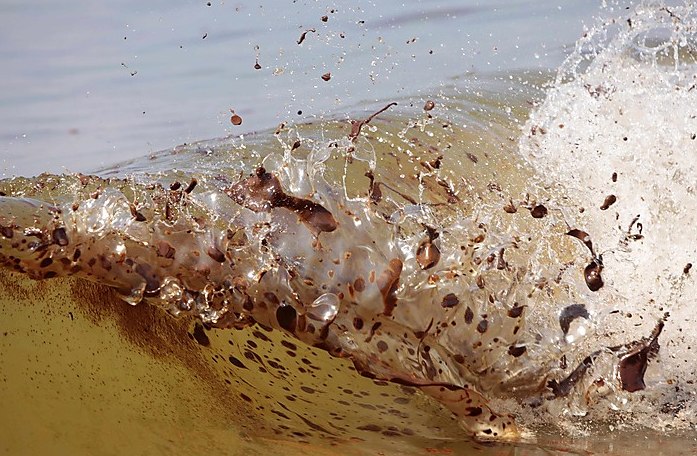
At what rate is crude oil pouring into the Gulf of Mexico? The latest government estimate is even higher than before: now it's 35,000-60,000 barrels per day. That's the equivalent of one Exxon Valdez every four days. Meanwhile, a lightning strike caused a fire on the ship that was siphoning off the oil, reducing the amount collected to 5,000 barrels today.
Meanwhile, the National Oceanic and Atmospheric Administration announced that this year's January-May period was the warmest on record, with records going back to 1880.
And tonight, Obama gave a speech from the Oval Office. Let's see if any of these noble words translate into action:
One of the lessons we've learned from this spill is that we need better regulations, better safety standards, and better enforcement when it comes to offshore drilling. But a larger lesson is that no matter how much we improve our regulation of the industry, drilling for oil these days entails greater risk. After all, oil is a finite resource. We consume more than 20% of the world's oil, but have less than 2% of the world's oil reserves. And that's part of the reason oil companies are drilling a mile beneath the surface of the ocean - because we're running out of places to drill on land and in shallow water.For decades, we have known the days of cheap and easily accessible oil were numbered. For decades, we have talked and talked about the need to end America's century-long addiction to fossil fuels. And for decades, we have failed to act with the sense of urgency that this challenge requires. Time and again, the path forward has been blocked - not only by oil industry lobbyists, but also by a lack of political courage and candor.
The consequences of our inaction are now in plain sight. Countries like China are investing in clean energy jobs and industries that should be here in America. Each day, we send nearly $1 billion of our wealth to foreign countries for their oil. And today, as we look to the Gulf, we see an entire way of life being threatened by a menacing cloud of black crude.
We cannot consign our children to this future. The tragedy unfolding on our coast is the most painful and powerful reminder yet that the time to embrace a clean energy future is now. Now is the moment for this generation to embark on a national mission to unleash American innovation and seize control of our own destiny.
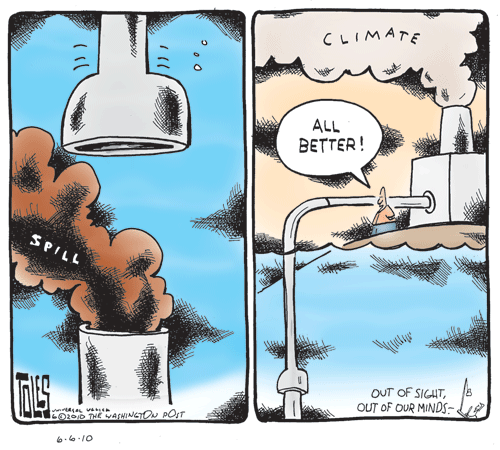
This spring, Britain came out with a report:
While the involvement of the private sector in the delivery of a geoengineering technique should not be prohibited, and may indeed be encouraged to ensure that deployment of a suitable technique can be effected in a timely and efficient manner, regulation of such techniques should be undertaken in the public interest by the appropriate bodies at the state and/or international levels.
Wherever possible, those conducting geoengineering research should be required to notify, consult, and ideally obtain the prior informed consent of, those affected by the research activities. The identity of affected parties will be dependent on the specific technique which is being researched - for example, a technique which captures carbon dioxide from the air and geologically sequesters it within the territory of a single state will likely require consultation and agreement only at the national or local level, while a technique which involves changing the albedo of the planet by injecting aerosols into the stratosphere will likely require global agreement.
There should be complete disclosure of research plans and open publication of results in order to facilitate better understanding of the risks and to reassure the public as to the integrity of the process. It is essential that the results of all research, including negative results, be made publicly available.
An assessment of the impacts of geoengineering research should be conducted by a body independent of those undertaking the research; where techniques are likely to have transboundary impact, such assessment should be carried out through the appropriate regional and/or international bodies. Assessments should address both the environmental and socio-economic impacts of research, including mitigating the risks of lock-in to particular technologies or vested interests.
Any decisions with respect to deployment should only be taken with robust governance structures already in place, using existing rules and institutions wherever possible.
Also, between March 22nd and 26th, there was a
meeting at Asilomar
(on the Monterey peninsula in California) to discuss geoengineering.
My friend Gregory Benford went there, and I would like to interview him
about that someday.
June 17, 2010
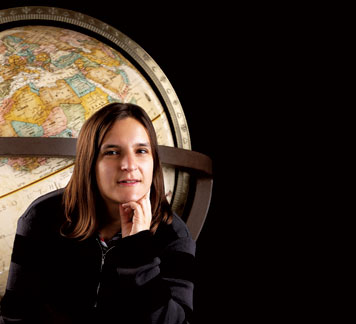
I read an interesting article about Esther Duflo, a scientist who helped found J-PAL, the Abdul Latif Jameel Poverty Action Lab at MIT:
She has really pushed the use of scientifically designed experiments involving randomized control trians to study the effects of social policies designed to help poor people. Don't just guess what's good: try things and study what happens! The New Yorker article quotes her as saying: randomization "takes the guesswork, the wizardry, the technical prowess, the intuition, out of finding whether something makes a difference." She's discovered a lot of interesting things by running these experiments. J-PAL teaches people how to run them, and you can even take an online course on how to run them:
Cool stuff! To get the big ideas, look at her slides:
Here is Lisa back in the days when taught at Bard College, probably somewhere about 1990-1994. We were hiking in the Catskills. I remember us climbing up a narrow rock passageway called the Lemon Squeezer. She looks so bright-eyed and happy! This makes me really sad about how we were stuck on opposite sides of the country for ten years. All that youth we had, wasted apart.
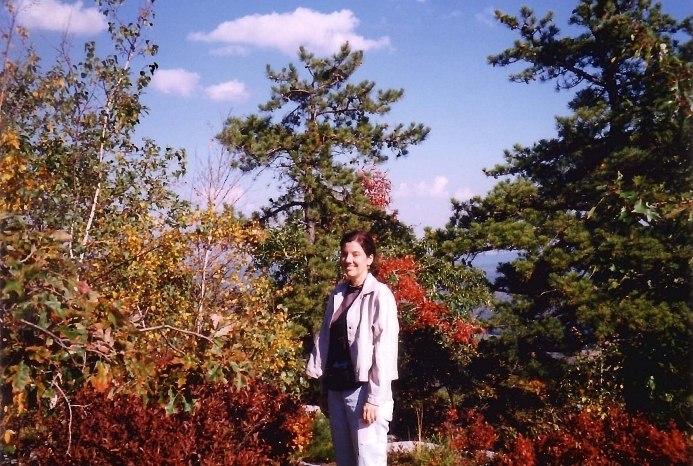
Here is one of my sister Alex and me in the woods near
our parents' house, examining a garden she'd planted:
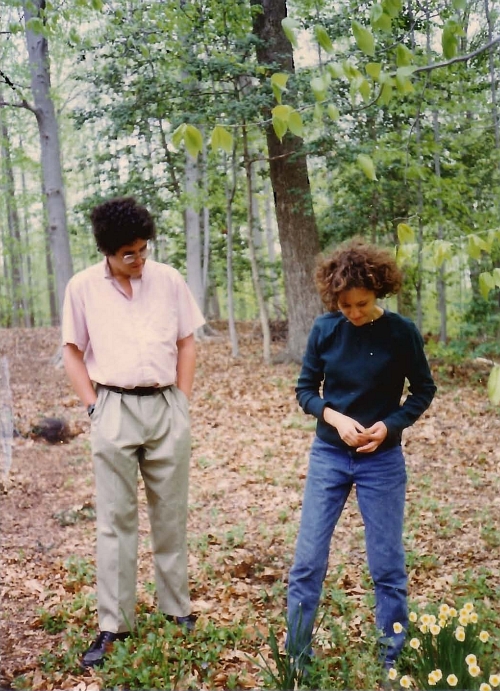
Here are Lisa and I at my parents' house around Christmas 1996:
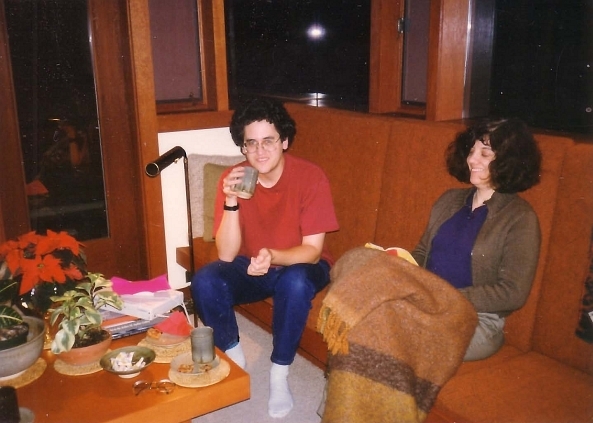
Here's my mother Phyllis along with my aunt Joan Baez Sr. (mother of the famous
singer), and her husband Albert Baez. This was taken in November 1997
at my uncle's house. My uncle and aunt were living separately at the
time, and had been for decades. But this was one his big birthday parties,
his 85th birthday in fact, so everyone was there:
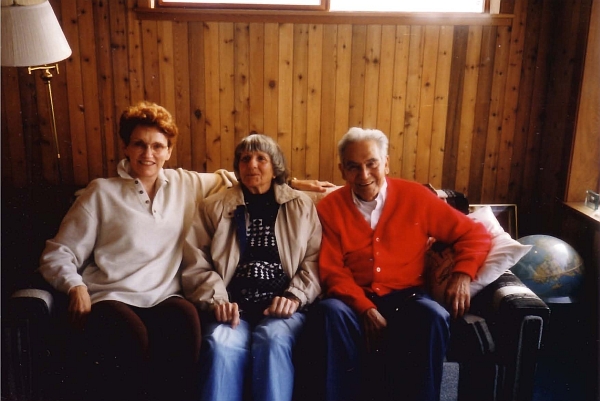
Here's one of my mother's sister, Marylin Goudzwaard, who lives in
Pasadena, along with my father Peter. This was taken in Monterey in
November 1997, so they must have taken a trip down there before or
after my uncle's birthday party. They are looking at pictures just
like I am now:
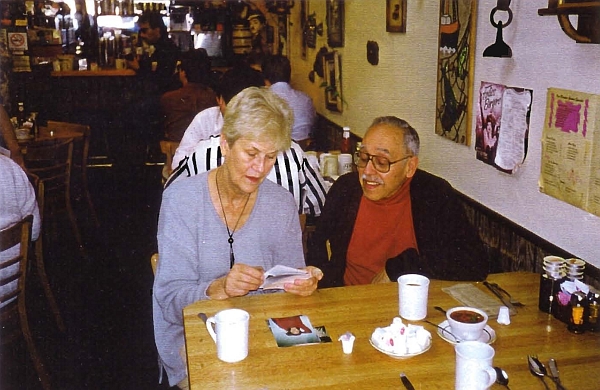
And on a different note... here are some of Kirill Krasnov, Fotini
Markopoulou and me. These were taken when I spent a few months at
Penn State. This is back when we were first beginning to understand
"spin foams".

And here's one of me taken in 1964, when I was three years old:
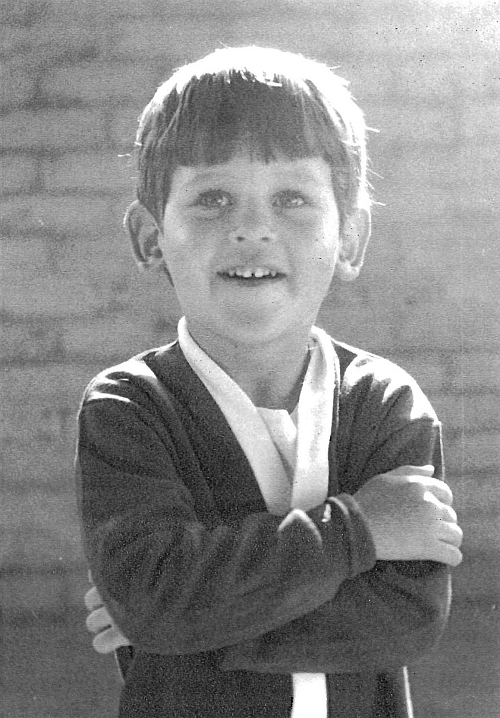
June 18, 2010
While there's lots of water on the planet, the supplies of drinkable
fresh water are getting severely strained. Want to know the big picture?
Read this:
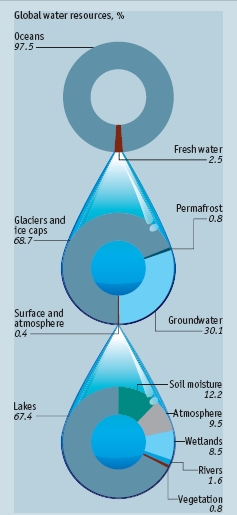
Only 2.5% of water on this planet is fresh water. Of that 2.5%, only 0.4% is on the surface or atmosphere.
When Bill Schmitt visited, we went to Tio's Tacos, which is teeming with strange sculptures, the creation of a feverishly inventive mind. Bill took these photos:

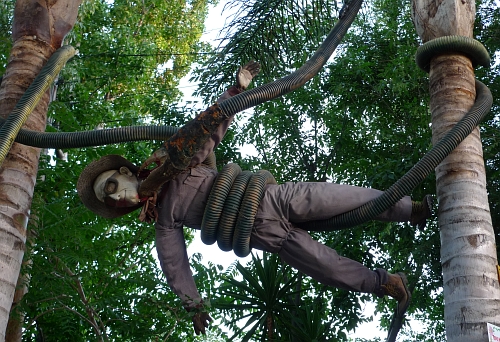

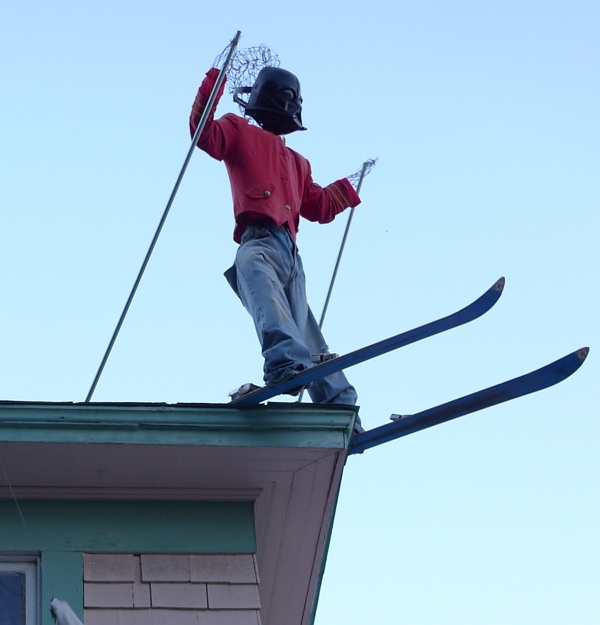

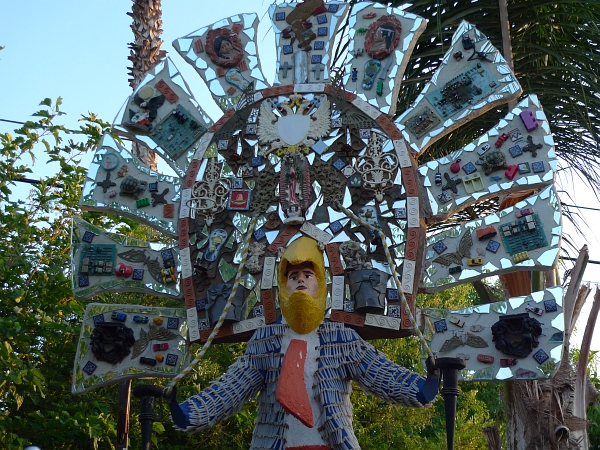
Scientists have recently discovered anaerobic animals called lorciferans — actual multicelled animals, not just single-celled organisms — that have adapted to deep ocean conditions by losing all their mitochondria and symbiotically acquiring new organelles that do the same energy-producing job without oxygen!
BackgroundSeveral unicellular organisms (prokaryotes and protozoa) can live under permanently anoxic conditions. Although a few metazoans can survive temporarily in the absence of oxygen, it is believed that multi-cellular organisms cannot spend their entire life cycle without free oxygen. Deep seas include some of the most extreme ecosystems on Earth, such as the deep hypersaline anoxic basins of the Mediterranean Sea. These are permanently anoxic systems inhabited by a huge and partly unexplored microbial biodiversity.
Results
During the last ten years three oceanographic expeditions were conducted to search for the presence of living fauna in the sediments of the deep anoxic hypersaline L'Atalante basin (Mediterranean Sea). We report here that the sediments of the L'Atalante basin are inhabited by three species of the animal phylum Loricifera (Spinoloricus nov. sp., Rugiloricus nov. sp. and Pliciloricus nov. sp.) new to science. Using radioactive tracers, biochemical analyses, quantitative X-ray microanalysis and infrared spectroscopy, scanning and transmission electron microscopy observations on ultra-sections, we provide evidence that these organisms are metabolically active and show specific adaptations to the extreme conditions of the deep basin, such as the lack of mitochondria, and a large number of hydrogenosome-like organelles, associated with endosymbiotic prokaryotes.
Conclusions
This is the first evidence of a metazoan life cycle that is spent entirely in permanently anoxic sediments. Our findings allow us also to conclude that these metazoans live under anoxic conditions through an obligate anaerobic metabolism that is similar to that demonstrated so far only for unicellular eukaryotes. The discovery of these life forms opens new perspectives for the study of metazoan life in habitats lacking molecular oxygen.
I read a cool article about sandfish: lizards native to North Africa that can literally swim through sand! People keep them as pets, which is not surprising, because they're incredibly cute:

On a different note, I took some lab tests yesterday. They encourage me to hope that a better diet and more exercise can help me beat my pre-diabetic condition. I've been trying to eat better and work out more, and it seems to be helping:
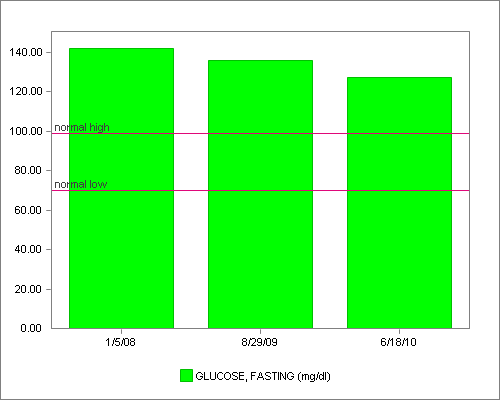
So yes, I'm trying to cut back on carbohydrates — thanks, folks, and
keep pressuring me to do it, because I'm finding it a tough addiction to
break. For some reason I repeatedly get into moods where I'm feeling
self-indulgent and want some sugar or alcohol. When I force myself to
stop, I almost feel the need to invent some new sins to make up for denying
myself these. It's a real nuisance. But I've also heard from reputable
sources that body
fat plays a role in adult onset diabetes. To fight that, exercise
also seems to help. Maybe not — Gary Taubes might disagree
— but anyway, exercise is good for plenty of other things too.
I like it, but I don't always make time for it.
In fact, maybe this should be my new self-indulgence!
June 20, 2010
Charles Grellois noticed my new interest in technology and sent me an email recommending that I study the work of Jacques Ellul and his friend Bernard Charbonneau (the latter apparently not much translated into English). In 1964 Ellul wrote a book called The Technological Society. Here's a summary from the Wikipedia article on him:
What many consider to be Ellul's most important work, The Technological Society (1964) was originally titled: La Technique: L'enjeu du siècle (which literally translates to "The Stake of the Century"). In it, Ellul set forth seven characteristics of modern technology.Since my wife Lisa studies classical Chinese and Greek thought, I am often made aware of how little government support there is for her activities compared to what I do. Somehow our government considers even the most rarefied mathematics more important than studying the history of how people think. This is odd, given how many of our problems involve people's thinking, world views, and implicit assumptions. But I've heard that a lot of recent work in the humanities — loosely speaking, postmodernism — shows little interest in a systematic study of these issues, the sort of study that could actually do the world some good.The characteristics of technique which serve to make efficiency a necessity are rationality, artificiality, automatism of technical choice, self-augmentation, monism, universalism, and autonomy. The rationality of technique enforces logical and mechanical organization through division of labor, the setting of production standard, etc. And it creates an artificial system which "eliminates or subordinates the natural world."
Regarding technology, instead of it being subservient to humanity, "human beings have to adapt to it, and accept total change." As an example, Ellul offered the diminished value of the humanities to a technological society. As people begin to question the value of learning ancient languages and history, they question those things which, on the surface, do little to advance their financial and technical state. According to Ellul, this misplaced emphasis is one of the problems with modern education.
This, according to Ellul, produces a situation where an incredible stress is placed on information in our schools. The focus in those schools is to prepare young people to enter the world of information, able to handle computers, but knowing only the reasoning, the language, the combinations, and the connections between computers. This movement is invading the whole intellectual domain and also that of conscience.
Ellul's commitment to scrutinize technological development is expressed as such:
[W]hat is at issue here is evaluating the danger of what might happen to our humanity in the present half-century, and distinguishing between what we want to keep and what we are ready to lose, between what we can welcome as legitimate human development and what we should reject with our last ounce of strength as dehumanization. I cannot think that choices of this kind are unimportant.
Ellul's ideas, or at least this tiny taste of them, again makes me
wonder how much I should "bracket off" questions of
philosophy, politics and ethics in the new series of This Week's Finds,
focusing on science and technology. Bracketing them off
could make it impossible to make progress on some really important
problems. On the other hand, getting involved in them seems like a
bit like diving into quicksand.
June 21, 2010
The moving van is about to come and take a bunch of our stuff to Singapore! Here's some of it sitting on our bed:

Yesterday BP siphoned off 23,290 barrels of oil leaking from the bottom of the Gulf of Mexico. It collected 14,570 barrels in the drillship Discoverer Enterprise, and it burned off 8,720 on the Q4000 oil rig, which has no way of holding the oil.
It turns out that early on, an internal BP document computed an initial worst case estimate of the oil spill was 100,000 barrels a day. This was around when they were publicly estimating 1,000 barrels a day. Need I say more?
A feel-good story:
My pals Chris and Menakshee are visiting! They recommend these books:
Alissa Crans and Tom Leinster used Skype to call me from Croatia, where they're vacationing.

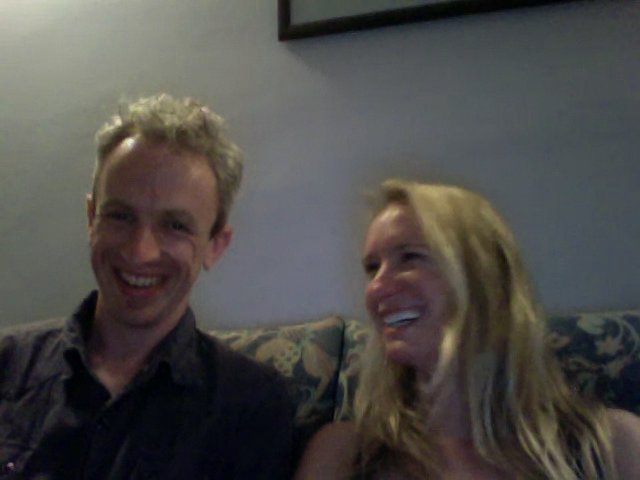
Lisa went on another trip to Erlangen yesterday; she'll return on July 5th and we'll take off for Singapore on the 9th. I'm using the week of solitude to move stuff out of my office at UC Riverside, since they'll be needing the room while I'm gone. It's a rare chance to sort through old files and throw out stuff that's no longer necessary. All the more so since I'm changing career directions, and various old preprints — I have a 5-foot-tall filing cabinet full of them — which once seemed to hold the keys to the mysteries of the universe now seem like pointless relics, worth tossing. Mainly it's the printouts of papers from the arXiv that seem unnecessary. Actual reprints, some signed by their authors, have more nostalgic value. A letter from Mac Lane, a letter from Witten — strange to think of those days before email! Lots of papers by my PhD advisor, Irving Segal. And notes that I took in courses... What to keep, what to dispose of?
For so long I'd been trying to learn all of pure mathematics (or at least everything interesting) that turning to a different goal — "saving the planet", as I modestly put it — makes me feel a bit like a cartoon character who had charged off a cliff, merrily unsuspecting until he looked down. What was I doing? Why so much math? Sure, it's beautiful, at least when you understand it. But why does it command such passionate energy to overcome all obstacles?
I'd actually taken a break from it until a few days ago. I was really trying to get up to speed on some environmental, technological, economic and political issues: trying to find the right places to chop the Gordian knot. Pure math seemed like a decadent waste of time, a hobby suitable for immortals basking in some intellectual Elysian fields, not us rats trapped on a failing planet. But then Todd Trimble figured out a beautiful way to fix and prove my conjecture about Schur functors. So, we wrote it up as an article on the nLab. And it was great fun for a few days, and it even points towards a bigger, better conjecture about the structure of Schur functors.
But right now, throwing out all these old math papers, I'm a somewhat different mood.
I just found a manuscript that had been sent to me by Rodger Cunningham of Sue Bennett College, Kentucky... a chapter book he was writing on the magician John Dee. And I just happened to open it to this page, which may answer the italicized question above:
In Plato's characterization of geometry as having to do with the knowledge of the eternal, not of the temporal, we find an escape from time — not only the time of generation and death, but also from the time of historical development. The early Egyptian praxis of geometria, earth-measuring, had indeed been in the cause of permanence over change — the permanence of human title to the earth over the changes imposed on it by the watery flow of nature. In this praxis there was indeed a germ of mathematics as an escape from mutability. But at this stage, [...] praxis was still intimately connected with the earth [...]. With the deliberate disconnection of this art from the earth came its transformation [...].In short, the only practical benefit of mathematics in which Dee is really interested is in the beneft to the mathematician himself.
© 2010 John Baez
baez@math.removethis.ucr.andthis.edu